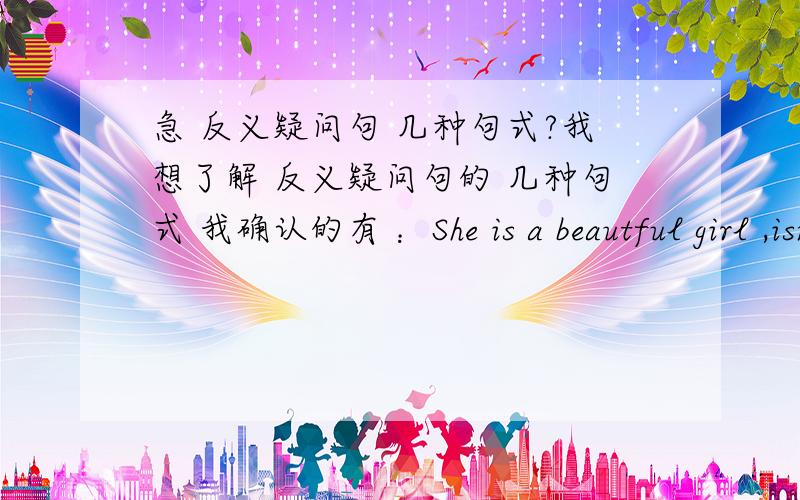急 反义疑问句 几种句式?我想了解 反义疑问句的 几种句式 我确认的有 :She is a beautful girl ,isn't she?let us go home ,will you
来源:学生作业帮助网 编辑:作业帮 时间:2024/11/28 00:30:51

急 反义疑问句 几种句式?我想了解 反义疑问句的 几种句式 我确认的有 :She is a beautful girl ,isn't she?let us go home ,will you
急 反义疑问句 几种句式?
我想了解 反义疑问句的 几种句式 我确认的有 :She is a beautful girl ,isn't she?
let us go home ,will you
急 反义疑问句 几种句式?我想了解 反义疑问句的 几种句式 我确认的有 :She is a beautful girl ,isn't she?let us go home ,will you
反意疑问句的基本形式
1.陈述部分是肯定形式时,其后的简短疑问部分为否定形式.例如:
He is a student, isn’t he?
2. 陈述部分是否定形式时,其后的简短疑问部分为肯定形式.例如:
He isn’t a student, is he?
反意疑问句的诸多特殊形式
1.陈述部分以“I am”开头时,简短疑问部分中用“aren’t I ?”.例如:
I am healthy, aren’t I?
2.陈述部分是“there be”结构时,简短疑问句部分由“助动词+there+?”构成.例如:
There won’t be any trouble, will there?
3.陈述部分的谓语动词是“have to +动词原形”时,简短疑问句部分中常有
“don’t/doesn’t/didn’t +主语+?”例如:
We have to finish it before eight o’clock, don’t we?
4.陈述部分的谓语动词是“used to +动词原形”时.简短疑问句部分中可以用
“use(d)n’t+主语+?”,“didn’t+主语+?”例如:
He used to take pictures there, use(d)n’t he? /didn’t he?
5.陈述部分的谓语动词是“ought to+动词原形”时,简短疑问句部分可以用
“oughtn’t+主语+?”,“shouldn’t+主语+?”例如:
He ought to go and ask her, oughtn’t he? /shouldn’t he?
6.陈述部分中的谓语动词为实义动词dare和need时,简短疑问句部分中用
“don’t/didn’t/doesn’t+主语+?”若句中的dare和need为情态动词.则简短疑问句部分中用
“dare/need+主语+?”,例如:
She doesn’t dare to go alone, does she?
He dare not say so, dare he?
7.如果陈述部分中用了加前后缀构成的含否定意义的词,则简短疑问部分中仍用否定形式.例如:
The meeting is unimportant, isn’t it?
Their plans are unpractical, aren’t they?
8.若陈述部分中用了no, never, few, seldom, hardly, little, scarcely, rarely, nowhere,
nobody, no one, nothing等表示否定或半否定意义的词,则简短疑问句为肯定形式.例如:
Few people went to see the film, did they?
9.若陈述部分中用了everyone, everybody, somebody, someone, anybody, anyone, nobody,
no one等不定代词作主语,则简短疑问句中的主语通常为they;如果在陈述部分中出现了单数形
式的物主形容词,则简短疑问句中的主语为he.例如:
Everyone got a new dictionary, didn’t they?
Everybody did his best to comfort her, didn’t he?
10.若陈述部分中的主语为everything, nothing, something, anything等不定代词,则简短疑问部分
中的主语为it.例如:
Everything is all right, isn’t it?
11.陈述部分中的主语是指示代词this时,简短疑问部分的主语为it;陈述部分的主语是指示代词
these或those时,简短疑问部分中的主语为they.例如:
This is an apple, isn’t it?
These are apples, aren’t they?
12.陈述部分的谓语动词是“had better+动词原形”时,简短疑问部分为“hadn’t+主语+?”,陈述
部分的谓语动词是“would rather+动词原形”时,简短疑问部分为“wouldn’t+主语+?”;陈述
部分的谓语动词是“would like to +动词原形”时,简短疑问部分为“wouldn’t +主语+?”
例如:
You’d better read it by yourself, hadn’t you?
He would rather read it ten times than recite it, wouldn’t he?
You’d like to go with me, wouldn’t you?
13.实义动词have的反意疑问句形式.
陈述部分中的have作“有”、“所有”解时,简短疑问部分为
“don’t/doesn’t/didn’t +主语+?”,但若陈述部分是否定形式,则简短疑问部分的作用词要
与前面的谓语动词保持对应关系.例如:
You have a bike, don’t you?
He doesn’t have a radio, does he?
She hasn’t a friend, has she?
14.have作“有”以外的其他意义解时,简短疑问部分中用
“don’t/ doesn’t/ didn’t+主语+?”.例如:
You have your lunch at school, don’t you?
15.不定式短语、动名词短语或名词性从句作陈述部分的主语时,简短疑问部分中的主语为it.例如:
Playing basketball is an interesting sport, isn’t it?
16.祈使句的反意疑问句形式
前一部分是肯定形式及否定形式的祈使句时,简短疑问部分中一般用“will you+?”;如果祈使句
含“邀请”之意,则简短疑问部分中常用“won’t you+?”.例如:
Let us go out for a rest, will you?
Don’t do that again, will you?
Do sit down, won’t you?
前一部分是表示建议的Let’s开头的祈使句时,简短疑问部分应为“shall we+?”.例如:
Let’s go out for a walk, shall we?
陈述部分为并列复合句时,简短疑问部分中的作用词应根据与之相近的分句的谓语动词形式而定.
例如:
We must start at once or we can’t get there on time, can we?
陈述部分含有“think, suppose, believe, expect, imagine+宾语从句”时,应依据下列规则确定其后简短问句的形式:
陈述部分主句的主语是第一人称时,简短疑问部分应依据宾语从句中谓语动词的形式提出.若think等动词为否定形式,则要注意否定的转移.例如:
I believe that you will pass the exam, won’t you?
I don’t think he can finish the work, can he?
(2)主句的主语不是第一人称,谓语动词为think, suppose, believe, expect, imagine及其他及物动词时,简短疑问部分则仍需要与主句中的主语、谓语保持对应关系.例如:
They don’t think she knew anything about it, do they?
He said he wanted to visit Japan, didn’t he?